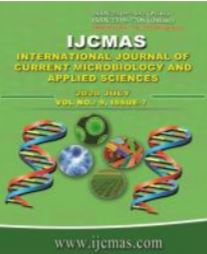


 National Academy of Agricultural Sciences (NAAS)
National Academy of Agricultural Sciences (NAAS)

|
PRINT ISSN : 2319-7692
Online ISSN : 2319-7706 Issues : 12 per year Publisher : Excellent Publishers Email : editorijcmas@gmail.com / submit@ijcmas.com Editor-in-chief: Dr.M.Prakash Index Copernicus ICV 2018: 95.39 NAAS RATING 2020: 5.38 |
Interspecific triploid hybrid was developed between tetraploid cultivated species Gossypium hirsutum cv. MCU 5 and CO 14 and diploid wild species Gossypium anomalum. The F1 hybridity was confirmed by morphological and cytologicalstud. The ploidy level of interspecific F1 hybrid was triploid and male sterile. Maternal parents MCU 5 and CO 14 had erect growth habit, green stem, palmate leaves, thick and prominent leaf veins, cream petals and embedded stigma. MCU5 was with dense yellow anthers while CO 14 dense creamy anthers, whereas male parent Gossypium anomalum has spreading growth habit, dull violet petals, pale brownish green stem, creamy white, thin leaf veins, embedded stigma and strongly hairyness plant body. The growth habit, leaf shape and petal colour and petal size of interspecific F1 hybrids were similar to the paternal parent. Plant stem colour, hairiness, leaf pubescence and anther colour of Gossypium anomalum were observed to be dominant as hybrid fully resembled Gossypium anomalum for these characters. Petal spot was observed in Gossypium anomalum and in F1 hybrids while petal spot was not observed in MCU 5 and CO 14. Variable expression of petal spot, anther colour and filament colour was observed in the F1 hybrids. The mitotic study revealed that the maternal parent MCU 5 and CO 14 with 52 chromosomes, Gossypium anomalum had 26 chromosomes and the interspecific F1 was with 39 chromosomes. Significant differences were observed between pollen size, pollen fertility of parents and their hybrids. The F1 interspecific hybrids having more than 97 percent of sterile pollen grains. This F1 may be utilized as a pre breeding genetic resource for transfer of cotton jassid resistance to American cotton in breeding programme.
 |
 |
 |
 |
 |